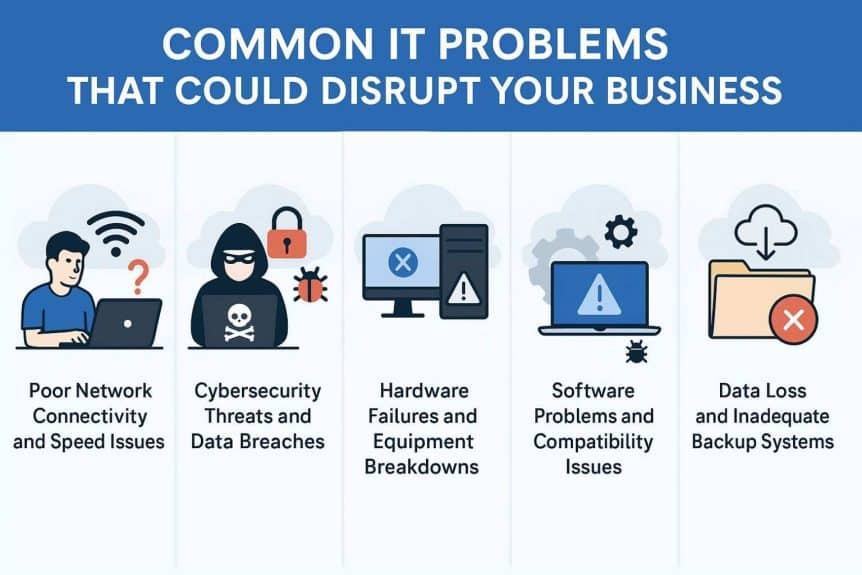Every business owner dreads the feeling when a technology system breaks down at a critical time. The server crashes just before an important presentation, or hackers breach your security during peak season. Such technology failures can close down operations and lose thousands in revenue. Technology is the bread and butter of business, and any failure is like a disaster waiting to strike. The trick is detecting trouble before it starts and having solid fixes ready to go. Most common IT problems in business can actually be prevented with some smart planning and reliable tech support.
Here are the most common IT issues in business and how they can be resolved.
Poor network connectivity and speed issues
A weak network performance is among the most frustrating IT problems in business. Slow internet speeds can turn simple tasks into time-consuming ordeals, while complete network outages can stop business operations entirely. Employees couldn’t access cloud applications, send emails, or take video conferences. The root causes are outdated networking equipment, bandwidth limitations, or ISP-related problems.
Solutions for network problems that actually work:
- Upgrade your internet plan to match what you really need today
- Replace old routers and switches with business-grade equipment
- Set up traffic rules so important apps get priority bandwidth
- Get a backup internet connection from a different provider
- Use monitoring tools to catch slowdowns before they become outages
Cybersecurity threats and data breaches
Cybersecurity is one of the most serious IT issues in business today. Hackers target businesses of all sizes, using methods like phishing emails, ransomware attacks, and malware infections. One wrong click on a fake email can lock up your entire computer system and expose customer information. In fact, cybercriminals target smaller organisations since they have less security, and your employees are most likely the weakest point, either downloading malware accidentally or handing out passwords.
Take these security strategies:
- Train your staff about suspicious emails, and check before sending sensitive information. Install good antivirus and anti-malware protection for SMEs on all computers and ensure that everything is updated with security patches. Install 2-factor authentication for important accounts and periodically back up data in different locations.
Hardware failures and equipment breakdowns
Computer hardware eventually wears out, but unexpected failures can cause major business disruption. These IT problems in business always seem to happen at the worst possible times, taking down multiple people’s work at once.
Too many businesses delay hardware upgrades and replacements until systems fail altogether, then scramble to find replacements while everything comes to a halt. And the costs of unexpected downtime and emergency repairs often cost more than the price of planned upgrades.
Hardware management solution:
- Do equipment replacement schedules based on manufacturer recommendations.
- Monitor system health and watch for warning signs like strange noises, frequent crashes, or systems running slower than usual.
- Keep spare parts inventory for important equipment.
- Use surge protectors and UPS systems for backup power supplies.
Software problems and compatibility issues
Software headaches come in all shapes and sizes, where programmes crash, updates corrupt the features, and older applications do not support newer systems. These business IT problems must be handled carefully to prevent worsening things.
Old software exposes you to security risks, but jumping on each update causes new bugs or disorients your team with interface changes.
So, make update schedules that fit with your business cycle, and be sure to test alternations on a small number of computers before rolling them out to the entire company. Please keep track of the software in use, when it goes out of license, and compatible software versions. Train people when you introduce new programs, and always have a way to roll back changes.
Data loss and inadequate backup systems
Data loss is one of the most devastating technology disruptions in business, which can destroy years of work in seconds. Whether it’s a crashed hard drive, a ransomware attack, or someone accidentally deleting the wrong files, data loss hits businesses hard. Customer lists, financial records, and project files represent the core of your operation that require protection.
So, follow these for effective data protection:
- Create your backups across multiple locations, such as local drives, network storage, and cloud services
- Set up automatic backups
- Do regular restoration testing to verify that backups actually work correctly
- Keep multiple versions of important documents
- Employee training on data handling procedures and backup protocols
Conclusion
Technology problems will always be part of running a business, but they don’t have to ruin your day. Network issues, security threats, hardware failures, software glitches, and data loss happen to everyone eventually. The businesses that succeed are the ones that prepare for these challenges instead of just reacting during emergencies. Good planning, regular maintenance, and reliable support can keep your technology running smoothly. So, connect with Cygent IT Services for reliable IT support for businesses and charities, which helps businesses stay ahead of these challenges with proactive support.




